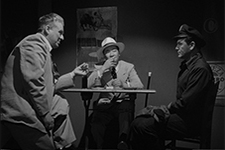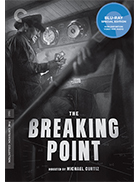The Breaking Point
|  Michael Curtiz’s The Breaking Point, an adaptation of Ernest Hemingway’s 1937 novel To Have and Have Not, ends with perhaps the bleakest image I can remember seeing in a classical Hollywood film. The image is so pointed, so unambiguously cruel in its way, that at first I didn’t fully believe that the film was actually ending there, fading out on a long shot of a child standing completely alone on a dock, looking for his father who he doesn’t know has been killed. He is orphan who doesn’t know it yet, caught in a brutal twist of fate made all the worse by the fact that he is a shy innocent. This child is, at best, a peripheral character in the film, although he is brought to the fore in these closing moments, his confused desolation standing as a symbol of life’s brutalities and the American economic system’s failure to care for its most vulnerable citizens (the fact that the child is black further reinforces those symbolic qualities, as his race makes him even more vulnerable in a country riven with institutionalized racism). The insistence and courage of this final shot elevates The Breaking Point from a very good film to a nearly great one. The central character is Harry Morgan (John Garfield), a charter-boat captain working out of a small port town in Southern California. His dream of owning his own boat and business are perilously close to financial ruin, a problem that is compounded when he is stiffed by Hannagan (Ralph Dumke), an ostentatious gambler who he and his first mate, Wesley (Juano Hernandez), ferry to Mexico along with his girlfriend, Leona (Patricia Neal). When Hannagan bails, Harry is left without enough money to even get out of port, which is why he allows himself to be taken in by F.R. Duncan (Wallace Ford), a shady lawyer with criminal connections. Harry is soon ferrying a group of illegal Chinese immigrants, a deal that goes south in all the worst ways and proves to make a bad situation worse. Harry is a fundamentally decent man who is driven not by greed, but by the desire to take care of his wife, Lucy (Phyllis Thaxter), and their two young daughters. He is a family man, a veteran of World War II, and someone who clearly believes that hard work and dedication will lead him to the American dream. And, while he tries to make ends meet through legitimate means, he finds that the odds and the economy are stacked against him, which later forces him back into the darker recesses of criminality (against the stern opposition of Wesley, who functions as his conscience), where he accepts a shady deal to aid in the escape of a group of gangsters who have just knocked off a racetrack. To Have and Have Not had been adapted just six years earlier by Howard Hawks, starring Humphrey Bogart and Lauren Bacall. That version of the film was not particularly well received despite the star power in front of and behind the camera, and part of the criticism was that the storyline diverged so far from Hemingway’s original novel (which, interestingly, was one of his least critically well-received works). Screenwriter Ranald MacDougall, who had previously worked with Curtiz on Mildred Pierce (1945), sticks much closer to Hemingway’s novel, although he also adds in quite a bit of new material, including the character of Leona, a classic femme fatale who clearly wants to lure Harry into infidelity if only because he appears so unwilling; she is determined to corrupt him, to bring him into her world where conventional morality is little more than an inconvenience. MacDougall’s screenplay also focuses much more on Harry’s domestic life, which is crucial to the film’s effectiveness in the way it establishes the stakes of his financial desperation. The scenes inside the Morgan house are initially bright and cheery, although they take on a darker, more despondent tone as Harry becomes more and more desperate, wracked with sleeplessness and guilt over his inability to provide for his family and Lucy’s having to take a job sewing at night just to keep the lights on. Phyllis Thaxter gives Lucy a palpable sense of decency that makes her a natural foil for the slinky and corrupt Leona, although she is no sap, even when she dyes her hair blonde in an obvious and desperate bid to compete for her husband’s wandering attention. Garfield, who had already headlined a number of memorable films including The Postman Always Rings Twice (1946) and Body and Soul (1947), is particularly well suited to playing desperation, and he gives Harry a poignant sense of failed manhood. He is, like many noir protagonists, a war veteran who returned to a country of closed frontiers and failed promises, which gives his struggle a profound metaphorical urgency. By the time he directed The Breaking Point, Michael Curtiz was entering the twilight of his career. He had been directing since the early 1910s, first in his native Hungary and then in Hollywood when he was put under contract by Warner Bros. and became one of their most successful and prolific directors. Often mislabeled as a “journeyman,” Curtiz was an artist of impressive range and dexterity who brought a unique sensibility to all of his projects, which cover virtually every genre and includes such classics as Angels With Dirty Faces (1936), The Adventures of Robin Hood (1938), Yankee Doodle Dandy (1942), White Christmas (1954), and, of course, perhaps the most famous classical Hollywood film of all, Casablanca (1942). Unfortunately, despite its compelling story and genuine artistry, The Breaking Point had little impact at the time of its theatrical release and became an almost forgotten film. It was quietly released with minimal advertising due to the fact that Garfield had just been listed in Red Channels: The Report of Communist Influence in Radio and Television, which made him and anything with which he was associated a major liability for the studio (he was subsequently blacklisted and died of a heart attack a year later). Thankfully, The Breaking Point has since been rediscovered and elevated to the place it deserves, but was long denied, among both Curtiz’s immense body of work and the film noir genre.
Copyright © 2017 James Kendrick Thoughts? E-mail James Kendrick All images copyright © Warner Bros. / The Criterion Collection | |||||||||||||||||||||||||||||||
Overall Rating: 


 (3.5)
(3.5)


